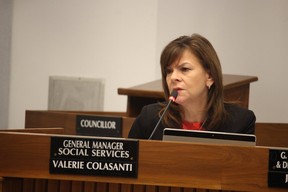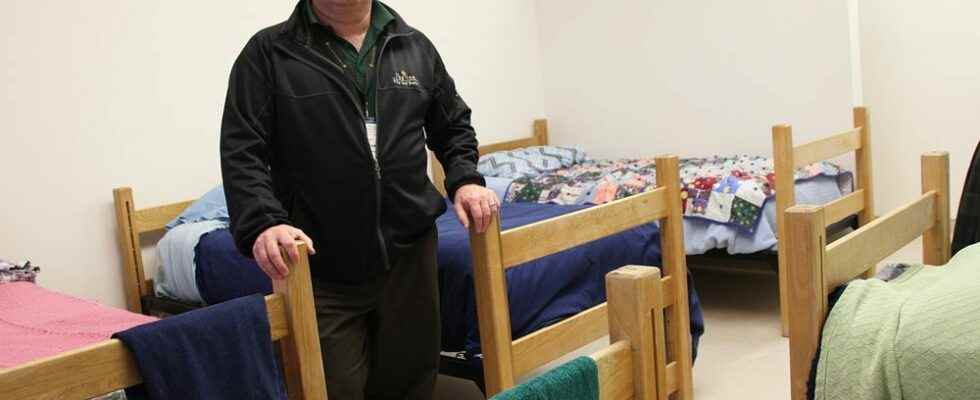Having more than 50 people “living rough” on the streets is something the Sarnia area hasn’t experienced before, says a senior Lambton County administrator.

Having more than 50 people “living rough” on the streets is something the Sarnia area hasn’t experienced before, says a senior Lambton County administrator.
As general manager of social services, Valerie Colasanti and her staff lead local efforts to respond to what has been a growing problem for the community since the pandemic began.
A report by the county’s social services division in mid-October says more than 170 individuals were homeless, including more than 50 identified as “sleeping rough” at some point in the past few months.
“Before COVID, we rarely saw people on the streets,” Colasanti said.
“This is very concerning to us.”
About 60 individuals were using emergency housing in the area before the pandemic began, said the report.
“The pandemic severely exacerbated the scope of housing vulnerability in our community as we saw a drastic increase in households experiencing some form of homelessness,” it said.
“For the first time, many households required access to basic needs assistance including shelter and food security supports.”
Ontario provided extra money early in the pandemic so Lambton could open additional temporary shelter space and services for individuals experiencing homelessness but that funding ended this year and the emphasis shifted back to prevention.

The county, as the designated service system manager, oversees homelessness programs in Lambton and assigns funding from the provincial and federal governments to local agencies, as well as providing services itself.
Lambton also worked with other agencies to develop a local 10-year housing and homelessness plan.
“There is a lot of work happening right now in the area of homelessness prevention,” Colasanti said.
“That’s where we’ve put most of our funding,” while also continuing to fund emergency shelter, she said.
Prevention work includes community support workers focused on “finding suitable, safe, affordable apartments” for those experiencing homelessness, “and then making sure the individuals have all the supports they need to be able to remain housed,” Colasanti said.
That includes connecting them to services from the Canadian Mental Health Association, addiction services and other local agencies, she said.
A housing and homeless advisory committee made up of agencies providing services meets regularly, plus county managers and staff are in regular contact with those partners.
Recently, Lambton added three more community support workers and now has about seven in total working specifically on homelessness prevention.
Two work on “rapid re-housing” with individuals at risk of losing housing, or who recently lost housing, Colasanti said.
The county also has four community support workers in its public housing division, which owns and operates 830 units.
“They work specifically with individuals who are housed but are at risk of losing their tenancy for a variety of reasons,” Colasanti said.
The county recently worked with the Sarnia-Lambton Children’s Aid Society, Canadian Mental Health Association and North Lambton Community Health Center to use federal funding to put staff in place to work with youth experiencing homelessness.
Lambton also has two contract workers in a federally-funded pilot program working with police and community agencies “to go out and meet with people” living on the streets to encourage them to go to the shelter, or connect them with help if they choose not to, Colasanti said.
The county identified 52 individuals in August living rough and only 15 per cent of them said it was because there were no shelter beds available, Colasanti said.
“Eight-five per cent just really don’t want to go into shelter,” she said.
Other reasons were concerns about safety, personal relationships, substance use and mental health, said the report.
Colasanti said officials are hopeful more will go to the shelter as colder weather arrives, “but we’re not sure.”
That’s why it’s important frontline staff are out there working with those experiencing homelessness, she said.
“We certainly don’t want anyone freezing on our streets.”
An important advance has been creation recently of what’s known as a ‘By-Name List” that offers a “real time count” of the number of individuals experiencing homelessness in the community, Colasanti said.
“It’s the first time we’ve actually had real data, as opposed to anecdotal data,” she said.
Since March of 2020, 529 individuals have been diverted from emergency housing and 311 experiencing homelessness have been helped into more permanent housing, the report said.
Recently, the county made a change to its centralized waitlist for its public housing so that now one in every 10 vacancies will be offered to an individual on both the waitlist and the By-Name List of those experiencing homelessness.
“It could be someone living in the shelter,” Colasanti said. “It could be someone precariously housed and couch surfing.”
The county’s community support workers will work with those individuals “to make sure their tenancy is successful,” she said.
Lambton already gives priority to domestic violence and human trafficking victims, as required by the province.
“The number of individuals that are homeless is growing, even with all the work,” Colasanti said.
She pointed to the fact social assistance payments in Ontario haven’t been raised in five years, plus the shortage of affordable housing in the community.
“Those long-term solutions are really needed,” Colasanti said.
“One of our biggest needs is for supportive housing” with staff and programs to help tenants remained housed, she said.
Colasanti said the county has been lobbying upper governments for funding for what it sees as a need for 15 to 20 supportive housing units.
Recently, Colasanti and the manager responsible for the county’s homelessness efforts were in Toronto at a national conference of the Canadian Alliance to End Homelessness to look for ideas of other things Lambton could be doing.
Earlier this week, Lambton County council backed Sarnia Mayor Mike Bradley’s call for the county to organize a community summit on homelessness early in 2023 with local agencies, as well as MPPs and MPs.
“This is urgent,” Bradley said. “I recognize there’s plans in place but also I think, from anecdotal information, that we need to up our game.”
Colasanti said local agencies were part of the forming of the county’s housing and homelessness plan, but that was before the pandemic began and the situation changed.
“Bringing people back together to see if there are any different ideas or anything we’ve missed, I think is probably important,” she said.
A summit can also “bring more awareness to the situation, and perhaps it will help us with our funding,” Colasanti said.
“I see it as an opportunity to just continue the discussion and the work.”
